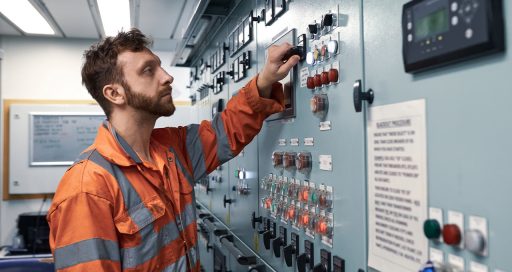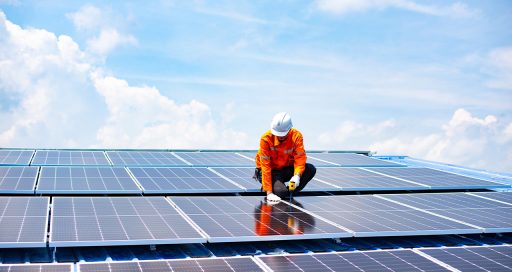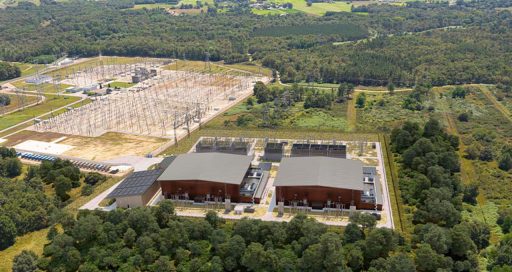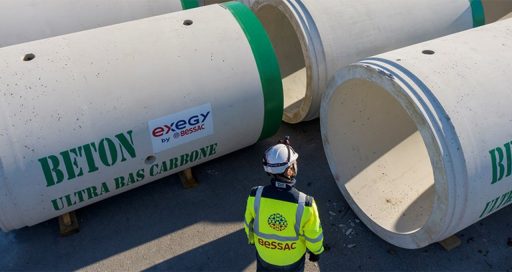Maritime transport is as polluting as air transport or the whole of Germany. The climate emergency is spurring key players in this vital sector of the global economy to accelerate its rollout of ships with lower emissions.

The International Maritime Organization (IMO) foresees a possible doubling of sea transport traffic by 2050. This is a less-than-encouraging prospect in terms of the fight against global warming.
International maritime transport is already one of the world’s biggest polluters, alone accounting for 3% of greenhouse gas emissions, on a par with air transport or the whole of Germany. The sector consumes 400 million tonnes of fuel a year, of which cargo accounts for 250 million, though this represents 80% of all goods transport worldwide.
However, it is important to note that maritime transport is by far the cleanest mode of transport per tonne-kilometre of goods moved.
The climate emergency has prompted legislators to encourage the use of vessels with lower emissions. In July 2023, the European Union approved the new “FuelEU Maritime” regulation. From January 2025, large cargo vessels will be subject to the European Commission’s wider “Fit for 55” legislative package.
This text introduced in 2021 aims to reduce emissions in Europe by 55% from 1990 levels by 2030, with a view to achieving carbon neutrality by 2050.
“Most of the technologies required are already available.”
The legislation also applies a new framework, applicable from 1 January 2024 onward to all merchant vessels and passenger ships with gross tonnage of 5,000 or more: the European CO2 Emissions Trading System. Tariffs based on the shipowner’s emissions are now applied to goods entering Europe, and customers will receive invoice surcharges based on this.
But policies to decarbonise maritime transport are not confined to Europe. On 7 July 2023, the 175 UN member states adopted the 2023 IMO Strategy on Reduction of GHG Emissions from Ships, with enhanced targets to tackle harmful emissions.
This strategy includes a reinforced shared ambition to reduce net greenhouse gas emissions from international shipping to zero by around 2050, a commitment to ensure an uptake of alternative fuels with zero or near-zero GHG emissions by 2030, as well as indicative checkpoints for 2030 and 2040.
Substantial investment
Member states are not the only entities mobilising. In December 2023, encouraged by major cargo shippers demanding zero-carbon vessels, five major shipping firms (CMA CGM, MSC, Hapag-Lloyd, HMM and A.P. Moller-Maersk) committed to the total decarbonisation of maritime transport by 2050.
This declaration, entitled Joint private and public Commitments in favour of the decarbonisation of maritime transport and also signed by France, Denmark and South Korea, is a world first. The initiative was presented in December 2023 at COP28 in Dubai.
This commitment comes with a further ambition of setting a firm date beyond which all new vessels built must be powered by transition fuels. Moving beyond liquefied natural gas (LNG), which is not a “green” fuel, the initiative seeks to promote biomethane and e-methanol until such time as hydrogen and ammonia become viable.
The capital required to decarbonise ships will fluctuate between an additional 8 and 28 billion dollars (€7 billion and €26 billion) a year until 2050, according to a United Nations costing. Added to which, between 28 and 90 billion dollars a year will be required for port and energy infrastructure upgrades.
The leading maritime transport companies have made a clear statement of intent, and now they must begin to adapt. The challenges are huge, both technically and financially. They will require reconfiguration of a market in which the key players are already highly concentrated. But pressure from shippers could accelerate progress. In 2021, companies including Amazon, IKEA, Inditex, Michelin, Patagonia and Unilever came together to form a new network known as coZEV (Cargo Owners for Zero Emission Vessels), in partnership with NGO The Aspen Institute, with the aim of transporting all their cargo on zero-carbon ships by 2040.
Ports join the movement
Maritime transport’s decarbonisation trajectory is not only of concern to shipowners and their customers. The electrification of ports will also play an important role in the sector’s energy transition, especially for passenger ships, which spend more time in port. The comprehensive solution dubbed OPS (Onshore Power Supply), of which Actemium, the VINCI Energies industrial brand has made a speciality, represents real progress.
But “Increasing demand for electricity due to the electrification of ports requires improvements to local power supply networks,” says Bruno Nicolas, Brand Director at Actemium, which recently created Actemium Marine.
The tidal wave of progress has also reached river transport. Its carbon impact three to five times lower than that of road transport gives river transport a card to play to its advantage. Its key players are trialling various routes toward carbon neutrality. Significant resources are being deployed to improve the energy efficiency of river craft and reduce their polluting emissions (electric, hybrid and hydrogen-powered boats), and also to modernise the waterways.
A fine example of this is the Centre Bourgogne canal system lock modernisation initiative, organised by Voies Navigables de France (VNF), the French navigation authority, with support from VINCI Energies, as is the Vedettes de Paris electrification project on the Seine. In the context of ecological transition, the potential impact of this is huge in a country like France, which boasts Europe’s largest waterway network.
Three solutions and some limits
Whether on the river or the ocean, Bruno Nicolas believes that the solutions for phasing out heavy fuel oil fall into three categories.
He explains, “The simplest way is operational improvement (using digital to optimise timetables and onboard energy management, slower speeds, etc). The second solution is technical: improving vessel design (hydrodynamics, modernisation of engines, wind-assisted propulsion, etc.). And third, the use of alternative fuels (LNG, biofuels, and e-fuels such as hydrogen, e-methane, e-methanol and ammonia), is essential to decarbonising maritime transport.”
However, experts emphasise that the various alternative energy sources are still beset by uncertainties, and indeed limitations.
“All low-carbon fuels rely on limited resources, such as renewable energy or biomass,” says Nicolas Meunier, head of the Mobility division at Carbone 4, an energy and climate consulting firm. “And maritime transport is in fierce competition with other sectors, which will limit the activity volumes available for achieving carbon neutrality. And the other barrier is financial. All these new solutions impose significant extra costs, which have to be passed on to the end user.”
There is no single comprehensive solution. Only a combination of different solutions will make it possible to achieve the stated objectives. Bruno Nicolas concludes that “These multiple initiatives make the stated objective for 2050 a credible one, especially as, unlike with air transport, most of the technologies required are already available.”
“Making river transport more competitive than roads”
Goods and passengers are also transported by river. HAROPA PORT, which incorporates the ports in Le Havre, Rouen and Paris, is France’s principal port and largest logistics hub. As such, it has a key role to play in decarbonising the sector. Christophe Gauthier, HAROPA PORT’s Project Management and Engineering Director at its regional headquarters in Le Havre explains the challenges.
What are the main challenges in achieving carbon-neutral river transport?
Christophe Gauthier: The main challenge is to expand this high-volume mode of transport, which generates four times fewer CO2 emissions per tonne than road transport. Even just reducing the pressure on major roads would significantly reduce the carbon impact of transport as a whole. But to do that, we need to make river transport more competitive than roads, either in terms of cost, frequency or reliability. Given that the last mile is usually by truck, the load break involved in using river transport means finding sufficient savings to offset that extra cost. You therefore need a high-performance logistics chain with the right connections and infrastructure.
What is HAROPA PORT’s roadmap in this area?
C.G. HAROPA PORT has been working to improve river transport on the Seine for more than a decade. Today, around 11% of container transport goods arriving or departing Le Havre on land use the river. But the river ports in the Seine basin are not all at capacity. Currently, about 200,000 containers go through our ports, but we could take double that with the existing infrastructure.
Which completed projects best illustrate the progress HAROPA PORT has made?
C.G. The completed developments and those still come at Port 2000, HAROPA PORT’s deepwater port dedicated to container traffic are testament to the improvements we have made in contribution to decarbonising maritime transport. Since 2010, river craft with suitable capabilities have been authorised to put to sea to collect containers from Port 2000. In 2013, a multimodal system using rail shuttles was introduced to optimise this transfer of containers to river boats. And we are currently working on a development project to allow all river craft to access Port 2000 without going by sea. The project starts this year, will take two or three years, and will resolve meteorological risks, reduce transport costs (because it will allow all types of river craft to access Port 2000 whatever the weather), and increase transport capacities. Also, a river traffic management system was implemented five or six years ago, and electric charging points have been installed all along the river for use by container barges. In fact, around a hundred additional charging points are being installed as we speak.
Key figures and dates
3%: the proportion of worldwide greenhouse gas emissions attributable to maritime transport.
400 million: tonnes of fuel oil consumed in the sector every year, of which cargo accounts for 250 million.
80%: proportion of goods transported by sea worldwide.
2021: creation of coZEV (Cargo Owners for Zero Emission Vessels) network.
July 2023: adoption of the European Union’s FuelEU Maritime regulation and of the 2023 IMO GHG Strategy.
December 2023: five shipping companies commit to the total decarbonisation of maritime transport by 2050.
January 2024: European CO2 Emissions Trading System.
04/16/2024





